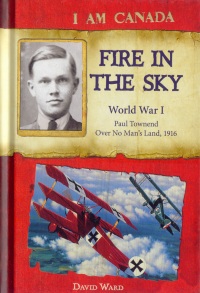| ________________
CM . . .
. Volume XX Number 11. . . .November 15, 2013 
 |
Fire in the Sky. (I Am Canada).
David Ward.
Toronto, ON: Scholastic Canada, 2013.
237 pp., hardcover & EBK, $14.99 (hc.).
ISBN 978-1-4431-0400-5 (hc.), ISBN 978-1-4431-2852-0 (EBK).
Subject Headings:
Richthofen, Manfred, Freiherr von, 1892-1918.
World War, 1914-1918-Aerial operations, Canadian-Juvenile fiction.
Grades 5-10 / Ages 10-15.
Review by Dave Jenkinson.
***½ /4
|
| |
|

excerpt:
“Contact!” the mechanic shouted.
“Contact!” Mr. Martin said.
The mechanic gave the propeller a hard swing, followed by another, and another. Suddenly the prop turned fully around on its own. The engine coughed. The prop continued to turn, slowly at first, caught once, and then turned faster and faster, with the engine coughing and sputtering. Then the engine roared to life and the propeller turned with such speed I could no longer follow its rotations. Wind blasted in my face and the plane became a living thing, pulling and tugging on its wheel blocks as if it wanted to leap into the skies.
July 28, 2014, will mark the 100th anniversary of the outbreak of World War I, “the war to end all wars.” Fire in the Sky, part of the “I Am Canada” series aimed at middle school males, follows Paul Townsend, a young Canadian fighter pilot, as he battles in the skies over the Western Front during that war. The war’s beginning actually found 17-year-old Paul and his older brother Robert working alongside their parents and younger sister, Sarah, on the family farm near Winnipeg, MB. Fueled by patriotism, Robert enlists in early September, 1914, in one of the Winnipeg regiments that were part of the Canadian Expeditionary Force. Because Paul’s labor is needed on the 500 acre farm, Paul agrees to delay enlisting, and he waits until his nineteenth birthday in August, 1916, before joining the Royal Naval Air Service, his choice of service branch being decided by a chance sighting of an airplane in flight a year before.
Initially, Paul is sent for flight training to the Curtis Aviation School in Toronto. There, he meets 20-year-old Billy Miller, and the two become comrades-in-arms. After only 15 hours in the air, Paul receives his wings, “[and] because they are short of pilots at the Front”, in October, 1916, both Paul and Billy, as newly minted Flight Lieutenants, are shipped to England via New York. In England, while receiving further training, Paul runs out of fuel, and he must make a forced landing in a farmer’s field. This unplanned event leads to Paul’s meeting Nellie Timpson, the farmer’s daughter, “no more than a year or two younger than me, but [she] was the prettiest girl I’d ever seen in my life.” Their developing romance becomes one of the book’s subplots, one which reveals some of the social niceties of the period, including a man’s having to ask a woman’s father for permission to marry her.
Most of the book’s contents, however, deal with Paul’s time at airfields near the front where long, long hours of waiting to be sent on a sortie are sandwiched around minutes of adrenaline-producing combat with German fighters or bombers. For pilots of the period, fire in the sky usually meant their fuel tank had been punctured and ignited by an enemy’s bullet. Because Allied pilots during World War I were not equipped with parachutes, fire also normally meant death. Author Ward provides twenty-first century readers with a very accurate portrayal of what it might have been like to pilot bi- or triplane aircraft constructed principally of cloth, wood and wire in life or death aerial combat, but he also effectively paints a picture of the dreadful life of the foot soldier in the trenches via Robert’s letters and the brothers’ meetings while on leave.
Though the Red Baron appears as a subject heading for Fire in the Sky and his triplane appears in the cover illustration, von Richthofen is actually a very minor character in the book; however, both Paul and Billy do encounter him in the air. A combat-related wound leads to Paul’s being sent home before the war’s conclusion, but not all of his fellow pilots are as fortunate as many, including Billy, are killed in aerial combat or in flying accidents.
Regular readers of books in the “I Am Canada” series will recognize that Fire in the Sky utilizes the structural conventions of the series, including chapter headings that incorporate the dates of the chapter’s action, a concluding “Historical Note”, and several pages of black and white photos and other illustration appropriate to the book’s historical period. For another look at World War I, middle-schoolers could be directed to John Wilson’s Shot at Dawn which is told from a soldier’s perspective and is also part of the “I Am Canada” series.
Highly Recommended.
Dave Jenkinson, CM’s editor, lives in Winnipeg, MB.

To comment
on this title or this review, send mail to cm@umanitoba.ca.
Copyright © the Manitoba Library Association. Reproduction for personal
use is permitted only if this copyright notice is maintained. Any
other reproduction is prohibited without permission.
NEXT REVIEW |
TABLE OF CONTENTS FOR THIS ISSUE
- November 15, 2013.
AUTHORS |
TITLES |
MEDIA REVIEWS |
PROFILES |
BACK ISSUES |
SEARCH |
CMARCHIVE |
HOME |
